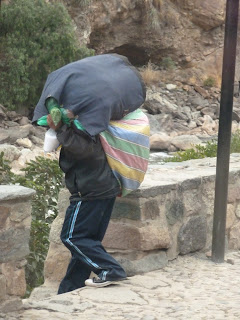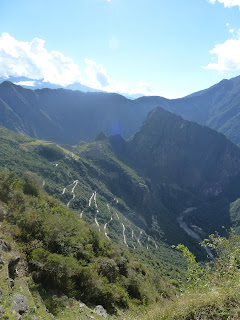1. Cooking class
It's not often that I see a cooking class offering Peruvian food even in such a international town such as Boston. Most of the time what's offered is a class on Mexican or Spanish cuisine so when I told about this class, I immediately signed up especially when I found out there were only 10 spots. It was a school night, but since it was so unique, I could justify it to myself. My husband and I got to the kitchen that Monday night, and there was chicha morada, a purple corn drink, already waiting for us. It was delicious. Then, we went into the kitchen with the rest of the group where we got down to business. The first job was to make the ají amarillo paste which was the base for the appetizer, papas a la huancaina. After, we helped cut up the beef and vegetables for the lomo saltado which was going to be our main course.
Our chef was a young man from Peru who had studied in culinary school, met an American girl, got married to her, and moved to the States. It made me smile to see how seamlessly they switched between English and Spanish. I definitely hope to keep in touch with him. I would love to find some way to have my students learn from him (if this isn't Community strand I don't know what is!). Not only did I learn about the dishes, but I also learned the right way to chop food thanks to him although I don't know if I will ever be as good as him.
Anyways, back to the food. I didn't eat my typical after-school snack because I did not want to spoil my dinner. By the time we were ready to eat, I was starving, but after taking the first bite, I realized it was totally worth the wait. My Peruvian friend said he wanted to cry because it reminded him of home - the food was that good. Our compliments to the chef!
Luckily, we didn't have to wait to long for dessert. The chef came up with the dessert on his own. It was grilled pineapple with chicha morada ice cream topped with chopped apples. It was simple and fabulous. A great end to the night.
I am so glad I went. It was a great night out, and I learned a lot in the meantime. I hope that there are more classes like this offered so I can learn to prepare them at home so Peruvian can be the norm and not the exception.
 |
| Peeling the skin off of the peppers |
 |
| Telling us about the food |
 |
| Papas a la huancaina |
 |
| Lomo saltado |
 |
| Grilled pineapple with chicha morada ice cream |
A few years ago, when Toms shoes were starting to grow in popularity, I told my students the story of Toms shoes and how the creator was influenced by a trip to rural Argentina where he saw children running around with no shoes. (Also reminds me of Shakira's Pies Descalzos foundation.) I told the students that it's not a coincidence that the label for Toms shoes looks like the Argentinean flag. The goal of Toms shoes is to donate a pair of shoes for every pair bought from them. It's an inspiring story of how Americans are trying to make a difference in Latin America.
Last weekend, I learned about a local Boston start-up that is selling apparel so that they can donate a portion of the proceeds to partner organizations who then help provide people access to clear water. Their mission has affected such countries as Bangladesh, Rwanda, Peru, Haiti, Kenya, Tanzania, and even United States.
The company is called Janji (http://runjanji.com). They had a booth set up in the hall where I had to pick up my bib for the road race I was going to run the next day. I was excited to buy a shirt that says "Run for Peru" with a llama on it. I know that if I wore it to school the students would DEFINITELY ask me about it. It would start a conversation about how local people are making a difference in the world. My hope is that maybe they can be inspired to do the same.
 |
| Fun shirt! Definitely a conversation starter. |
As the summer approaches, try to look for opportunities to keep learning right in your own backyard. It's easy to do! What are you waiting for?

















































